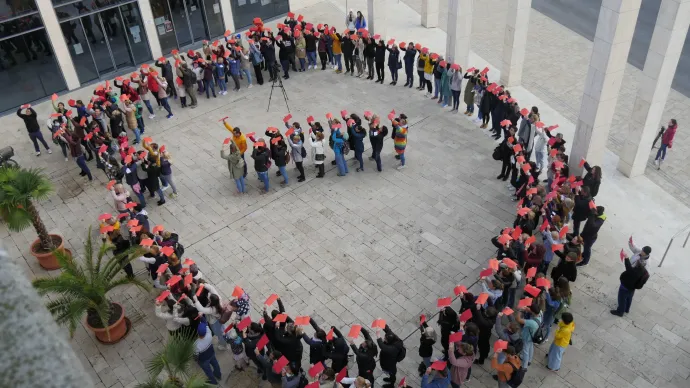On Friday, all across Hungary, teachers went on strike or practiced civil disobedience, with parents and students expressing their support in various ways. The difference between the two is that striking is a legal protest regulated by law, while civil disobedience is not. We have written in detail about why Hungarian teachers have been forced to choose civil disobedience.

It would be impossible to list all the schools and the various protests that were organized all through the country, but here are a few:
- On Friday, almost the entire teaching staff and the administration department of Ady Endre High School in Ráckeve went on strike between 8 and 10 in the morning. Students and parents showed solidarity by 398 out of 453 students not coming to school. The students expressed their support by forming a human chain in front of the high school.
- 36 teachers and two staff members at Radnóti Miklós High School in Dunakeszi are on strike on Friday. Out of 771 students at the school, only 88 came to school. The others stayed away out of solidarity with their teachers.
- At the Richter Gedeon Primary School in Ecséd, 11 of the 13 members of the teaching staff were on strike on Friday, with only 36 of the 150 pupils going to school.
- In Zalaegerszeg, citizens formed a 1 kilometre-long human chain in the town’s centre to show their solidarity with teachers.
Friday’s events were inspired by the Teachers’ Unions (PSZ and PDSZ) who announced a country-wide strike for this day after nobody from the government had addressed their demands nor showed any willingness to sit down with their representatives.
The date is no coincidence, because it was exactly a year ago, on 14 October 2021, that the Teachers Unions (PDSZ and PSZ) formulated their strike demands towards the government, which they sent to Prime Minister Viktor Orbán the following day. On the occasion of the anniversary, PDSZ issued the following statement:
"For a year, the state has been humiliating the workers of kindergartens, schools, dormitories and specialised educational services by ignoring their demands, and now it is not even willing to sit down to the negotiating table with us. On top of it, they passed a law through which the state is preventing teachers from exercising the ultimate means of pressure available to an employee – striking".
Although the protest held in support of Hungarian teachers on October 5th in Budapest was the biggest protest in recent memory (with tens of thousands in attendance) there have been no reactions or comments from the Orbán government.
Until this Thursday, that is, when Gergely Gulyás, the PM’s Chief of Staff announced a 20,8% increase of teachers’ wages for 2023 and held out the prospect for more all the way until 2025 – of course, pending the EU approving the funds which have been withheld from Hungary due to concerns about rule of law and the independence of the judiciary.
The Teachers’ Union was unimpressed by this announcement and their vice-president commented that they believe the government's supposed intention to raise wages only serves the purpose of trying to curb the protests.
Another protest is set to be held late Friday afternoon in Budapest.
For more quick, accurate, and impartial news from and about Hungary, subscribe to the Telex English newsletter!
The translation of this article was made possible by our cooperation with the Heinrich Böll Foundation.